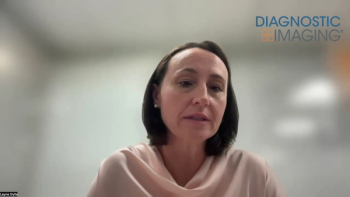
Ground-glass nodules merit scrutiny for differential diagnosis
Persistent ground-glass nodules in the lungs are worth a closer look, as they are highly associated with malignancy. Dr. Anne Leung offered an overview of how these lesions present on CT imaging at the 2008 Stanford International Symposium on Multidetector-Row CT in Las Vegas.
Persistent ground-glass nodules in the lungs are worth a closer look, as they are highly associated with malignancy. Dr. Anne Leung offered an overview of how these lesions present on CT imaging at the 2008 Stanford International Symposium on Multidetector-Row CT in Las Vegas. "Ground glass is defined as hazy or decreased attenuation on CT that does not obscure underlying bronchovascular bundles," said Leung, chief of thoracic imaging at Stanford University School of Medicine. "The pathologic correlates that have been described with ground-glass nodules are partial airspace filling, interstitial filling, edema, fibrosis, and neoplastic infiltration." Leung pointed out that ground-glass nodules have two subtypes: pure ground glass and ground glass with solid components. Ground-glass nodules with solid elements are more likely to be malignant, particularly if they persist over three months, she said.
Leung highlighted some of the differential diagnoses that can be made on CT when ground-glass nodules are present:
- lymphoma
- focal interstitial fibrosis
- primary neoplastic diseases and their precursors
Among the primary neoplastic diseases, she described atypical edematous hyperplasia. The CT features of these peripheral lesions are a size of less than 5 mm, round or oval shape, smooth margins, and pure ground-glass appearance.
Focal ground-glass nodules with solid components are also found with bronchoalveolar cell carcinoma. Other CT features to look for are air lucencies, smooth or irregular contours, and slow growth, Leung said. Finally, there is adenocarcinoma, the most common lung cancer in the U.S. CT features of this disease state are focal ground-glass nodules with solid elements, air lucencies, and smooth or irregular contours. Leung concluded that persistent ground-glass nodules are best seen with thin-section imaging. Readers should keep an eye out for solid components and interval growth. Finally, she recommended against evaluating ground-glass nodules with PET studies, as negative results are generally not a reliable indicator of benign disease.
Newsletter
Stay at the forefront of radiology with the Diagnostic Imaging newsletter, delivering the latest news, clinical insights, and imaging advancements for today’s radiologists.



























